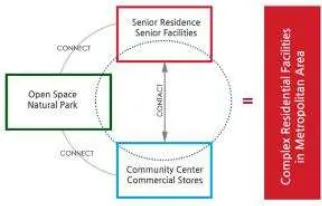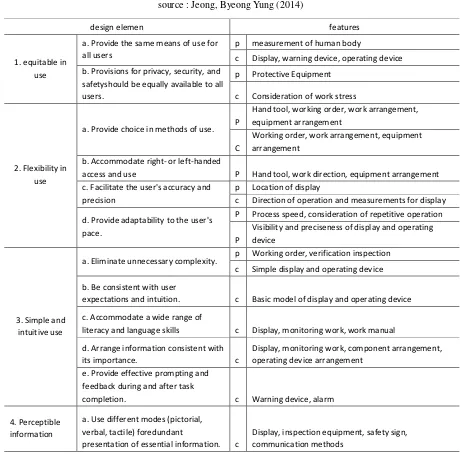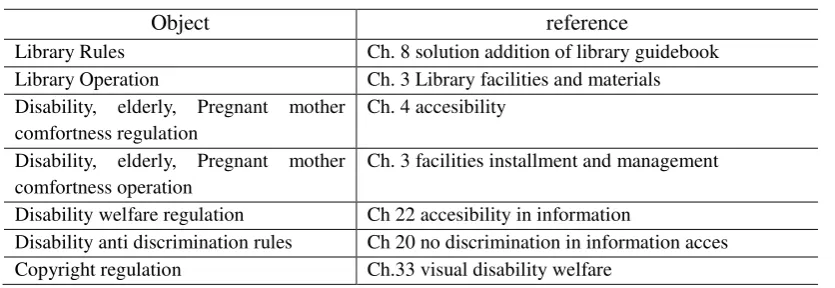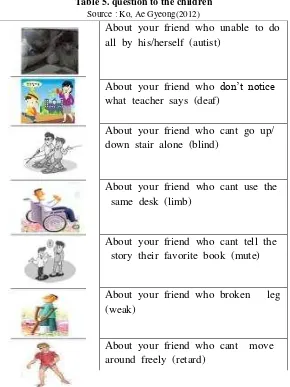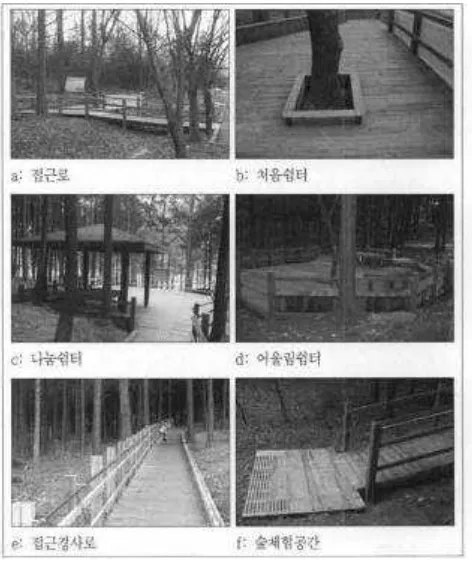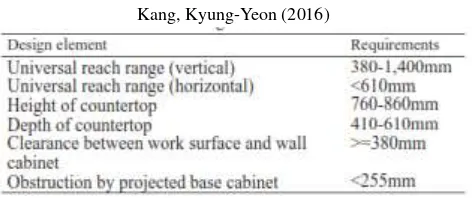13
UNIVERSAL DESIGN APPLICATION THROUGH SOUTH KOREA
REDEVELOPMENT
(A Study Review)
By Bangun Indrakusumo RHa a
Architecture Departement of Engineering Faculty, Diponegoro University, Indonesia Abstract
The evolution toward Universal Design was began in the 1950s with a new attention to design for people with disabilities. At the same era South Korea began their development after several wars. Recently some of researchs and projects in South Korea which conducted on Universal Design concept are increasing in quantity and widening in multidiciplinary areas to make a better living for people in South Korea.
This study examined those researches and projects to determine the progress of Universal Design principles application in South Korea in several periods and evaluated the result by the project’s purpose. This study is a review from several literatures related to universal design application in South Korea.
The Review revealed that South Korea has published regulations, guidelines and law based on universal design principles. South Korea has established universal design principles as fundamental basis in designing and developing their public space, public facilities building and elderly residential houses. Application of universal design influenced the knowledge of diversity for people especialy in disability and elderly. Universal design encourage people with diversity in ability, ages, gender to live together without barrier to access and use every facilities in their regions.
Keywords : Universal Design, Development, South Korea, Review, Diversity
INTRODUCTION
Universal design (also called inclusive design or accessible design) refers to facility designs that accommodate the widest range of potential users, including people with mobility and visual disabilities and other special needs. The evolution toward Universal Design was began in the 1950s with a new attention to design for people with disabilities. Universal design (also called inclusive design or accessible design) refers to facility designs that accommodate the widest range of potential users, including people with mobility and visual disabilities and other special needs. Universal design should be comprehensive from origin to destination for the greatest possible range of potential users. Universal design should consider all possible obstacles that may exist in buildings, transportation terminals, sidewalks, paths, roads and vehicles.
14 Table 1. People with Disability Employment in South Korea
.(Source:KEAD, 2013 on https://www.kead.or.kr)
The projection South Korea population based by the ages shown that number of elderly will increase constantly each year (see table 2). That condition needs to be responded by government and scientist to facilitate and anticipate the prediction. Therefore several project and research are running in this study area.
Table 2. Population of Elderly in South Korea
unit thousand persons % per 100 female population
Period 65 or more Males Females Sex ratio
(Source: Statistic Korea Population Projection, 2011 on http://kostat.go.kr )
In aims to anticipate and facilitate the elderly and disability right, South Korea starts to study and apply universal design principles on every buildings and public facilities from early 80’s as the rise of Korea development begins. South Korea together with China and Japan were developed universal design for the three nations, with the aims having standard adopted the world wide.
Following those trends and focused on South Korea, this study examined those researches and projects progress of Universal Design principles application in South Korea in several periods and
15 evaluated the result by the project’s purpose. In other means, this study review from several literatures related to universal design application in South Korea.
UNIVERSAL DESIGN STUDY IN SOUTH KOREA
Universal design is worldwide design movement as support for independence and participation has evolved in response to demographic expand and social condition of more people living with a wide range of disabilities and various health conditions than before and the longest lifespans in records. Universal Design is the design of products, environments, and communication to be usable by all people, to the maximal extent possible, without adaptation or specialized design. The concept is also called inclusive design, design-for-all, lifespan design or human-centered design.
Universal design is a philosophy of design which removed distinctions among varying abilities by adhering to four major principles which identified by Ron Mace:
1. supportive: it makes environments work for the individual, stressing ease of use and maintenance.
2. adaptable: it serves a wide range of users whose needs change over time.
3. accessible: the everyday comforts and conveniences that “normal” individuals enjoy are provided to all users of the environment.
4. safety: it not only provides environments and tools for the presently disabled, but also anticipates and prevents disabilities such as repetitive strain injuries.
The further developments of these principles have provided a standard to the products and environments which can be measured (Null, 2014). As the movement has grown, universal design principles have continually been evaluated and refined. The center for universal design at North Carolina developed an expanded list of seven principles of universal design which were represented by ten UD advocates as : Bettye Rose Connell, Mike Jones, Ron Mace, Jim Mueller, Abir Mullick, Elaine Ostroff, Jon Sanford, Ed Steinfeld, Molly Story, and Greg Vanderheiden. The list of seven principles of universal design are :
1. Equitable Use :
The design is useful and marketable to people with diverse abilities. 2. Flexibility in Use :
The design accommodates a wide range of individual preferences and abilities. 3. Simple and Intuitive Use :
16 language skills, or current concentration level.
4. Perceptible Information :
The design communicates necessary information effectively to the user, regardless of ambient conditions or the user's sensory abilities.
5. Tolerance for Error :
The design minimizes hazards and the adverse consequences of accidental or unintended actions.
6. Low Physical Effort :
The design can be used efficiently and comfortably and with a minimum of fatigue. 7. Size and Space for Approach and Use :
Appropriate size and space is provided for approach, reach, manipulation, and use regardless of user's body size, posture, or mobility.
The application of Universal design principles in South Korea has been performed in several case and multidisciplinary views. This study has resumed in period of 90es until recent South Korea development through universal design into 3 section of better living aspects, which are :
1. Residential facility (Home) 2. Workplace/ Education (Work) 3. Leasure/recreation place (Play)
RESIDENTIAL FACILITIES
17 Figure 1. universal kitchen design concepts
source : Ko, Young-Jun (2011)
This study found remodelling kitchen set which fit to Korea dietary life and affordable to be installed in apartements. This study suggested applicable alternatives for five unit types without increasing the current kitchen size. From this, the possibility for designing a more universal kitchen within the current kitchen area size has been demonstrated. Thus, it could be concluded that the usability and accessibility of the spatial layout of a kitchen would be more easily affected by the spatial distribution of appliances and the relationship between them than the size and shape of the kitchen. Therefore, for the application of universal design to kitchen design, considerations not only of the size and shape of the kitchen and its appliances, but also of clear floor space, work triangle, countertop, reach range, and knee clearance formed by the location of each appliance are required (see figure 2).
18 The kitchen set design in bigger case can be applied as part of elderly house design or silvertown with some modification related the character, capacity and minimum facility that required by the house (see figure 3). The approach to elderly who have disability and low physical ability was applied in every rooms and spaces in this elderly house.
Figure 3. Integrated elderly unit design source : sora, lee (2012)
The elderly houses is not just single support building. The concepts of integrity in living were promoted the house into city part which need to be connected with openspace (play) and community center (work). Diagram of connectifity between live-work-play which represented by housing-openspace-community center can be seen on figure 4. The connections between each place must be provided in every city especialy in metropolitan area to improve the living quality of every people.
Figure 4. Integrated elderly house concept source : sora, lee (2012)
WORKPLACE
19 capabilities is often a factor in their injuries and poor job performances. This mismatch is more likely happen among older workers. Principles of "universal design" seek a safe, effective product and environment that people with widely ranging differences in age, size and other characteristics can use. Creating an age-friendly workplace is a collaborative work of ergonomics, human factors, and universal design. They together manage the challenges of balance, vision, hearing, strength and endurance faced by aging workers (Silverstein, 2006)
The specific parameter shown from Universal design in workplace is detailed on table 3 below. The parameter devided the features into physical and cognitive features.
Table 3. Universal Design in working place source : Jeong, Byeong Yung (2014)
design elemen features
1. equitable in use
a. Provide the same means of use for all users
p measurement of human body
c Display, warning device, operating device b. Provisions for privacy, security, and
safetyshould be equally available to all users.
p Protective Equipment
c Consideration of work stress
2. Flexibility in use
a. Provide choice in methods of use. P
Hand tool, working order, work arrangement, equipment arrangement
C
Working order, work arrangement, equipment arrangement
b. Accommodate right- or left-handed
access and use P Hand tool, work direction, equipment arrangement
c. Facilitate the user's accuracy and precision
p Location of display
c Direction of operation and measurements for display
d. Provide adaptability to the user's pace.
P Process speed, consideration of repetitive operation
P
Visibility and preciseness of display and operating device
3. Simple and intuitive use
a. Eliminate unnecessary complexity. p Working order, verification inspection c Simple display and operating device
b. Be consistent with user
expectations and intuition. c Basic model of display and operating device
c. Accommodate a wide range of
literacy and language skills c Display, monitoring work, work manual
d. Arrange information consistent with
presentation of essential information. c
20 b. Provide adequate contrast between
essential information and its
surroundings c Color, location, size of display
c. Provide affordance c Shape, icon, operation button, design
d. Provide compatibility with a variety of techniques or devices used by
people with sensory limitations. c Warning, sounds alarms, display
5. Tolerance for error
a. Arrange elements to minimize
hazards and errors c Operating device, operation Information s Prevention of malfunction, tamper proof b. Provide warnings of hazards and
errors s Offer feedback
a. Allow user to maintain a neutral
body position p Work at knuckle height, normal work area
b. Use reasonable operating forces p
Force limit for pushing and pulling, recommended weight of carry and lifting
c Indicator of heavy weight
p Hand tool, simple assemble of parts
c. Minimize repetitive actions. p Protective gear and equipment
d. Minimize sustained physical effort. c Work and posture training
7. Size and space for approach
and use
a. Provide a clear line of sight to important elements for any seated or
standing user. c Component arrangement, height of worktable
b. Make reach to all components comfortable forany seated or standing
user. p
Component and tool arrangement, width of worktable, width of cart
c. Accommodate variations in hand
and grip size. p Hand tool, operating device
d. Provide adequate space for the use of assistive devices or personal
assistance. p Work space, reach distance, clearance
p =physical c=coginitve s=safety
21 EDUCATION BUILDING
Universal design application on education building is related to the school facilities, including class and library. Several regulations related to the education building codes were published by the authority of South Korea. The universal design concepts were adapted on those codes, especialy in accessibility and perceptible information principles (see table 4).
Along with physical development related to universal design, the cognitive and knowledge about universal design also being studied in South Korea. The main purpose of universal design in learning is to elaborate the physical building and mental building inside every people to support each other. Korea young generation must know and learn about diversity in ability and cognition that need to be embraced and collaborated.
At several school in South Korea, people with disabilities were being facilitated to study together with other students without any special class for them. However, the universal design tools were installed in purpose to encourage their independence in living. There was study about awareness of diversity in students in elementary school which show a basic knowledge about accepting and understanding universal design in needs, some several question for identifying universal design knowledge can bee seen on figure 5.
Table 4. Universal Design on education buildings
source : Kim boil (2011)
Object reference
Library Rules Ch. 8 solution addition of library guidebook Library Operation Ch. 3 Library facilities and materials
Disability, elderly, Pregnant mother comfortness regulation
Ch. 4 accesibility
Disability, elderly, Pregnant mother comfortness operation
Ch. 3 facilities installment and management
Disability welfare regulation Ch 22 accesibility in information
22 Table 5. question to the children
Source : Ko, Ae Gyeong(2012)
Table 6. Universal Design Principles Consideration on children at school
Source : Ko, Ae Gyeong(2012)
Universal Design Consideration
Category Sub category Children answer
Universal Design Answer
Partial consideration Comfy, amaze, danger, nice
writing (21)
Car Accident , death cause accident (7)
etc Not understand and no answer (0)
In conclusion, this study was found to be an effective method for changing young children’s understanding of the universal design concept and their understanding of young children with disabilities positively. As they understood the universal design concept and realized that individual’s abilities are different regardless of whether they have a disability or not, this concept may be applicable as an effective method to reduce fixed ideas or prejudices against disabilities (see table 6).
23 LEASURE/RECREATION PLACE
South Korea as one of the world top tourist destination is seriously prepare the infrastructure and facilities to be easily access and use by high range ability of tourist. Established tourist facilities for the disabled expands opportunities of tourism participation. The study proposed the deck model for improving disabled tourist activities in Hwajinpo tourists beach by applying universal design in terms of tour for all. The summary of result of this study was followed. The monitoring Hwajinpo beach was conducted and it found the present conditions and problems. Some improvements and deck model were suggested by applying the universal design according to the results. First, the efficiency of sandy beach deck needed to be considered. Second, equipping special wheel chairs were suggested. Third, installation of tracks for closing to the sea were suggested. Through those suggestions, the final deck mode was suggested for improving disabled tourists in Hwajinpo tourist beach. The application of universal design for facilitating travelling with disability was very important issues, so this study was very meaningful. It is expected that various ways will be suggested by applying universal design for encouraging travelling with disability focused on various tourism destination (see figure 5).
Figure 5. Universal Design adjustment in the beach
Source : Lee, Yongjin (2011)
24 Figure 6. Application of Universal Design at Geonjisan
source : Park Sonah (2012)
a. pathway, b.personal restarea, c.collective rest area, d.rised rest area, e.accesible raiser, f.woodpath ground
The forest trail which had concept of woodpath and application of “bridge” above the topographic ground support the green-universal design proved that the ideal concept can meet the user satisfaction, especially for people aged over 60 years old who had been the participant in the post occupancy evaluation program (see figure 6).
THE IMPACT OF UNIVERSAL DESIGN IN SOUTH KOREA
The establishment of Universal Design in South Korea specialy in three sector mentioned above shown that the application is well installed and still developing into perfections.
In elderly housing (silver town) the relation between traditional habit of the occupant shown that universal design research can be started from specialized design to enrich the knowledge itself. The lift rack, lowered counter (sink), movable cabinet (under the cooktop), pullout cabinet, halogen cooktop, pullout tables which designed to facilite the disable people, can be used also by non disable user.
25 be useful in many ways, and some problems were also pointed out that need more adjustment to meet the universal design principles (see table 7).
Table 7. Universal reach range
Kang, Kyung-Yeon (2016)
The kitchen study can be widen into house criteria with dynamic range of universal reach and applied in every elderly housing in South Korea. The application itself already reach every province in Korea, eventhough not all elderly house applied this design (see figure 7).
Figure 7 Universal Design applied Elderly Housing in South Korea
26 Figure 8. Elderly uncovinient places in house
Source : Jung-an, Jang (2016)
The second place for people is their workplace/school which spend almost 60% of their time in a day to live in. The growth of employee with disability and elderly made the workplace need to be more friendly to those people.
The Law for Building Accessible to and Usable by the Older and Physically Disabled Persons has made terms like "barrier-free design/ accessibility" and "universal design" more common related to physical, cognitive and safety demands. Implementing Universal Design in their product design is a recent trend there. Manufacturers and advertising agencies have built a new marketing strategy that even helped businesses recover from their long recession.
There needs to be a resting lounge for older workers and disable. Stairs and wheelchair ramps should be adjusted to proper height and angle to prevent accidents. Slippery floors should be fixed and handrails should be installed for the stairs. Proper lighting must be provided for the workplace and the hallway along with an indicator for whenever the floor is of different heights.
The recommend handling area for heavy weight items is from "knee-height" to "acromion height." The lower limit is set at 95 percentile of the highest "knee-height" so that worker with big builds would not have to bend as much. The higher end is set at 5 percentile of the lowest "acromion height" so that shorter workers would not have difficulty. The upper limit of the recommended material handling area from Table is set at 129cm for men usage, 118.3cm for women, and 120.2cm for general usage. The recommended lower limit from Table 4 is set at 48.8cm for men, 44.5 for women, and 47.8cm for general usage.
27 create more tolerance and understanding amongst various people which support the universal education atmosphere.
Table 8 Life long learning in south korea by age cohort
Currently Korean society is experiencing the third-age phenomenon, and incoming older cohort is more educated and willing to engage in empowering social and economic activities than preceding ones. In facing the aging of the population and the aging workforce over the past and coming decades, inevitable changes in various spheres are expected and lifelong learning is assuredly one of them. Working and learning are the centrality of human life, which means a human being enjoys the meaning of life with balance in work and learning. For the older adults, learning and working entails not only economic survival and achieving the meaning of life personally, but also lessening the social burden. At the same time the society benefits by increasing a more educated population, resulting in a positive economic impact.
Figure 9. Tourism in South Korea
source : KTO (2009)
28 informations and transportation service officer who unable to speak in other languages. According to the situations, Korea government start to encourage people to study more other languages/cultures especially students and elderly.
Table 9 Character of tourist in South Korea
Source : Park, Sunga (2012)
The bridge ramps installment for universal accessible and safe path shown that the leasure places were design for all and no barriers. Refer to the table 9, the majority of tourists are elderly aged above 60 and ladies shown that the places are low physical effort, accessible and tolerate the error.
CONCLUSSION
The Review revealed that South Korea has published research papers, regulations, guidelines and built a lot of public facilities based on universal design principles. South Korea has established universal design principles study as fundamental basis in designing and developing their public space, public facilities building and elderly residential houses. Application of universal design influenced the knowledge of diversity for people especialy in disability and elderly.
Universal design facilities in South Korea had proven able to encourage people with diversity in ability, ages, gender to live together without barrier to access and use every facilities in their regions. The various people participations without any barriers in sharing the public place showed that assistive physical environment, cognitive development and safety place are universal demands regardless their diversity.
The further development challenges of universal design principles in South Korea through previous studies are cognitives area and integrating the specialized user/exclusive design into universal design enrichments.
ACKNOWLEDGEMENT
29 Supriyadi who always inspire me in architecture. Moreover, this keynote speaking opportunity also strongly related to him. Secondly, I thank my all Korean friends and my colleague while living in South Korea for supporting me in every aspects until recent conditions. Finally, my deepest respect to all DAFT members in person and team.
REFERENCES
Paper/journal references
Feng, li et al (2011) Study on the universal design for pedestrian space - Emphasis on Seoul’s public space design, Korean Institute of Interior Design 13(3) pp 70-74
Jeong, Byung Yong et al(2014). Workplace Universal Design for the Older Worker. Journal of Ergonomic Society of Korea, 33(5), 365-376.
John, Yong-Seok (2015) A Study and Evaluation on the Accommodations of Railroad Station Facilities in relation to Universal Design - Focused on major stations in some metropolitan cities - Journal Of The Architectural Institute Of Korea Planning & Design 29(11),pp 75-84 Kang, Kyung-Yeon et al(2016) Application of Universal Design in the Design of Apartment
Kitchens, Journal of Asian Architecture and Building Engineering vol.15 no.3
Kim, Bo Il et al (2011) Application of Universal Design in Public Library Services, Journal of Korean Library and Information Science Society 42(4) pp 181-201
Ko, Ae Gyeong et al (2012) The effects of kindergarten physical environment monitoring intervention activity based on the universal design concept to young children’s understanding toward their peers with disabilities, The Korean Journal of Early Childhood Special Education 2012, Vol. 12, No. 1, pp.137-164.
Lee, Gahng-Ju(2014) Establishing the Universal Design Guideline for Underground Public Pedestrian Facility - With Focused on the City of Seoul, Journal Of The Architectural Institute Of Korea Planning & Design 30(3), pp 63-71
Lee, Young Jin et al (2011) The Application of Universal Design of Beach Tourist Destination for Improving Accessibility of Travelling with Disability, Korean Journal of Physical and Multiple Disabilities Vol.54, No.4, 2011. 10. pp. 349~374
Lee, Sora et al (2011) A Study on Urban Complex Residential Facility for the Elderly Based on Universal Design Concept, Hanyang University Journal of Aging Society 2011 Vol. 2, No. 1, pp. 51-82.
Moon, In-Young et al (2014) The Evaluation of the Village Community Center in Aspects of Universal Design Principles - Focused on 25 Village Community Centers in Hwasoon Province, Korean Institute Of Interior Design Journal 23(1) pp 162-171
Null, R. (2014) Universal Design: Principles and Models, CRC Press Taylor & Francis Group, Boca Raton, FL October
Oh, Seung Ho et al (2014) A Study on the Direction of Product Design in terms of Universal Design through the Development of Basin Design for a Hospital, Journal of Digital Design 14(2), pp 589-598
30 Park, Yong Ki (2015) An evaluation on universal design of Seoul Forest, Journal of Digital Design
15(1), pp 775-784
Saito, Y., Awareness of universal design among facility managers in Japan and the United States, Automation in Construction, 15(4), 462-478, 2006. doi:10.1016/j.autcon.2005.06.013
Seo, Dong Ik et al (2013) An analysis on the universal design application to the Bukhansan National Park sign facilities : Focusing on Bukhansan Dullegil barrier-free trail, Archives of Design Research 26(1) pp, 483-505
Shin, Han-Na (2011) A Study on the Usability Evaluation of Universal Design Environment based on Needs for Elderly Housing in Seoul, Korean Institute of Interior Design, 13(3), pp 38-42
Silverstein, Nina M. and Vanderbur, Megan (2006) Community Mobility and Dementia: A Review of the Literature" Gerontology Institute Publications. 34.
Graduation/Presentation works
Chung, Jisung (2014) Working and Learning of the Aged in South Korea, Finance, Global Management, Economics & Information Technology Research Conference, New York, USA. Indrakusumo, Bangun (2016) Design Characteristic of Specialized Streets for Indonesia through
Cases of South Korea, Pukyong National University, Busan, South Korea
Jung-An, Jang (2016) The development and application of a residential environment evaluation tool for the elderly group home, Pukyong National University , Busan, South Korea
Ko, Young Jun (2011) Development of Kitchen Models for Wheelchair Users -Focused on the Development and Evaluation of a System Kitchen Model Which Reflects Conditions of
Korea and Universal Design Concepts- accessed at
http://www.idemployee.id.tue.nl/g.w.m.rauterberg/conferences/cd_donotopen/adc/final_paper/0 31.pdf&prev=search
Website references
Anonym (2016) https://kto.visitkorea.or.kr/eng/tourismStatics/keyFacts/KoreaMonthlyStatistics.kto
accessed on October 31st 2016
https://www.kead.or.kr accessed on October 31st 2016


